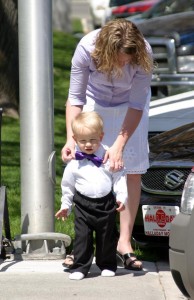
Month: October 2009
Day of the Dead, Lord of Life
cross posted at Civil Religion “Death be not proud,” taunted John Donne. “One short sleepe past, wee wake eternally, / And death shall be no more; death, thou shalt die.” Death interrupts our view of eternity, a fearsome jalousie obscuring a future we must approach. Like Donne, we console and distract ourselves by turns with bravado, with pleasure, with laughter and—finally, always—with God.
St Louis Mormon Historical Society meets Friday
Trivia fact for the day: the Mormon church operated a newspaper, the St. Louis Luminary, from November 1854 to December 1855. The periodical served the large community of transient Latter-day Saints, many of whom stopped in St Louis to replenish their strength (and funds) after the first leg of their journey to the Salt Lake Valley. In 1855, the paper commented, “There is probably no city in the world where Latter-day Saints are more respected, and where they may sooner obtain an outfit for Utah. … The hand of the Lord is in these things.” If you’re intrigued, and you live in the St Louis area, you can learn more about the early history of Mormons in St Louis at the first meeting of the St Louis Mormon Historical Society. The event will take place tomorrow night, Friday, October 30, at 7:00 pm at The Lodge Des Peres. It promises to be an interesting evening, and I’m hoping to attend myself.
The Zeal of a Convert
There’s an interesting new study from Pew about converts.
Same-sex Marriage and Change
Will same-sex marriage change the institution of marriage? Melissa Harris-Lacewell writes in The Nation that maybe, hopefully, it will.
The Dispensation of the Fulness of Times®
So the upcoming RS/MP lesson got me thinking: What exactly does the phrase “the dispensation of the fulness of times” actually mean?
The Nasty Side of Christian Ethics
The language of turning the other cheek and Christian ethics in general can really get quite nasty.
Halloween Costumes and Inner Conflict
Halloween scares me. Of course, I’m scared of lots of things—poverty, cancer, rape, gang violence, Satan, etc. I thought I should admit that up front. Make of it what you will.
President Monson wins the prize

So Slate keeps track of who it considers the most powerful octogenarians and President Monson tops the list. If ever there was a list where Mormons could shine that did not have to do with singing and dancing I guess it makes sense that it would be “powerful old men”. To loosely paraphrase President Hinckley, isn’t it wonderful to have somebody in there with decades of experience who is not moved about by every wind of doctrine?
Human life, religious voices and the public square
Cross-posted at Civil Religion. Last week the New York Times published a two–part series on artificial reproductive technologies. The series makes a riveting read, as writer Stephanie Saul narrates the joys and terrors of premature birth, high order multiples, NICU stays, and—finally, sometimes—the precious goal, a baby at home with a family.
A Mormon Image: Preparing for the Wedding Reception

Photo by L-s Sus, who writes:
The picture is of my wife and son and was taken at my sister’s wedding. It captures many themes that resonate with my concept of Mormon identity: Family, Motherhood, Nurturing, and Beauty. It also reminds me that we have benevolent heavenly parents who reach down and give assistance, and that we are just children in the grand scheme of things.
Photo Series: A Mormon Image

In an effort to increase the beauty-to-blather ratio around here, we’d like to kick off a new series of posts featuring photos and other images which carry meaning to us because they resonate with our Mormonness. And we’d like to include all of you in this project. That is, we’re inviting you all to send in submissions for the new T&S series, A Mormon Image.
MR: “Music From Across the Divide”
A new issue of The Mormon Review is available, with a review of the music of Sara Groves by Troy Keller. The article is available at: Troy Keller, “Music From Across the Divide,” The Mormon Review, vol.1 no. 7 [HTML] [PDF] For more information about MR, please take a look at the prospectus by our editor-in-chief Richard Bushman (“Out of the Best Books: Introducing The Mormon Review,” The Mormon Review, vol.1 no.1 [HTML][PDF]). In addition to our website, you can have The Mormon Review delivered to your inbox. Finally, please consider submitting an article to MR.
Gays and the Church: Whose Ox is Being Gored?
When people talk about Prop 8 or gay-Mormon relations generally, a common theme is that a smaller, less powerful group is the victim of an unfair attack from a larger and more powerful aggressor. This theme is used repeatedly on both sides of the debate. It was a central theme in Elder Oaks’ recent talk about religious liberty. And it was immediately raised in criticisms of that talk, with church critic Fred Karger telling the Associated Press, “They are trying to be the victim here. They’re not. They’re the perpetrators.” It’s clear that this basic framing is employed by both sides in the argument. This raises the question — who is the bully here? Whose ox is being gored? Interestingly *both* the LDS and gay communities have plausible evidence to support the claims that they are the victim group.
Are the Books Available?
It is a bit of a coincidence that, as I prepared my regular list of the books and other media mentioned in General Conference, one of the LDS discussion forums in Brazil I follow was lamenting the decision to discontinue selling classic LDS works in Portuguese, like Talmage’s The Articles of Faith and LeGrand Richard’s A Marvelous Work and a Wonder.
The Doctrine of Revelatory Justiciability
A good friend, while studying constitutional law for the bar exam this summer, emailed me some thoughts he scribbled down when he should have been hacking away at a few more MBE questions on judicial review. Instead, however, he hammered out a constitutional analysis on the justiciability of prayers. You see, in case you weren’t aware, in order to receive an answer to a prayer, one’s prayer must involve a “case or controversy” that is fit for review. So, without further adieu, allow me to present the doctrine of revelatory justiciability (a.k.a., what studying for the bar does to your brain).
Peace Prize Shock
At first I thought it might be a joke of some kind. I waited for a “just kidding” qualification from the radio news announcer. Then the news item finished. The Nobel Peace Prize was awarded to Barack Obama.
Holland and the gap, again
Leaving aside disagreements about Elder Holland’s tone and speculations about the talk’s effect on believers and skeptics—not that those are unimportant, but that they’re being vigorously played out elsewhere—I want to make a narrow point about the philosophical underpinnings* of his talk.
Christian Neighbors
When my neighbor four-doors-down called last night and asked if I could take dinner to my neighbor three-doors-down, I said yes. I’m a Mormon mom: dinner for a single, middle-aged man is no problem. It was the circumstances that made me pause.
John Alvon Glauser: Face to Face with History
Michelle Glauser is a young Mormon American woman living in Germany. I’ve long read her blog, Circles and Dots and Other Distractions, which is a riot of activity — she may be based in Leipzig, but she’s just as apt to be blogging about her trip through Turkey, or Switzerland, or Poland, as she is to be describing life as an ex-pat in a German university. Her recent master’s thesis is a serious study of the surprising meanings of blogging, especially mommy blogging.
Sunday Afternoon in a Nutshell
President Uchtdorf conducted the Sunday afternoon session, featuring talks by Elder Holland, Elder Cook, Elder Neilson, Elder Renlund, Elder Ringwood, Elder Sitati, and Elder Christofferson, followed by closing remarks from President Monson. Direct quotations (based on my notes) are given in quotes; phrases without quotes are my summary of the remarks given.
Sunday Morning in a Nutshell
President Monson conducted the Sunday morning session, featuring talks by President Eyring, Elder Perry, Elder Burton, Sister Dibb, Elder Nelson, and President Monson. Direct quotations (based on our notes) are given in quotes; phrases without quotes are our summary of the remarks given.
Conference Traditions
My son was none-too-thrilled to realize last night that by next General Conference he will be twelve and *get* to go to a two-hour meeting with his dad. We thought that reviving my husband’s tradition
Priesthood Session in a Nutshell
President Uchtdorf conducted the Priesthood session, featuring talks by Elder Ballard, Elder Gonzalez, Elder Choi, Elder Uchtdorf, Elder Eyring and President Monson. Direct quotations (based on my notes) are given in quotes; phrases without quotes are my summary of the remarks given.
Saturday Afternoon in a Nutshell
President Eyring conducted the Saturday afternoon session, featuring talks by Elder Oaks, Elder Hales, Elder Zeballos, Elder Callister, Elder Watson, Elder Anderson, and President Packer. Direct quotations (based on my notes) are given in quotes; phrases without quotes are my summary of the remarks given.
Saturday Morning in a Nutshell
President Eyring conducted the Saturday morning session, which featured brief remarks from President Monson and talks from Elder Scott, Sister Matsumori, Elder Clayton, Brother Osguthorpe, Elder Bednar, and President Uchtdorf. Direct quotations (based on my notes) are given in quotes; phrases without quotes are my summary of the remarks.
Royal Skousen’s 12 questions — The Critical Text Version
Last month we posted Royal Skousen’s discussion of his work on recovering the earliest version of the Book of Mormon, along with some updates. Unfortunately, that post garnered some annoying formatting problems — mostly due to the new format T&S adopted this year. We’re happy to now present to you mark III of Royal Skousen’s 12 questions interview. Royal Skousen’s book, The Book of Mormon: The Earliest Text, was published last month by Yale University Press and yes, you can order it at Amazon.
Diapers, Dishes, and Dusting
Yesterday, a Mormon Times article began with this opener: “For Finnish music star Mervi Hiltunen-Multamäki, trading in exotic concert locales, a prime-time TV show and platinum records for diapers, dishes and dusting was an easy decision. Maybe that’s because following the prophet has never been hard for her.”
A Call for Mormon Studies Papers — for Brazil
After a bit of work and discussion, a small group I’m working with has issued a call for papers for what may be the first academic conference on Mormonism not held principally in English. The conference will be held in São Paulo, Brazil this coming January.
The Songs of Lehi
If we accept, at least for the moment, that 1 Nephi has a textual history, that it drew on older sources or underwent expansion at various times, then we might wonder what could be considered the oldest layer of the text


